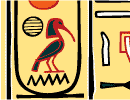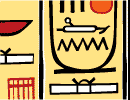Of his own abundant work at Giza, Hawass is especially proud of a
continuing excavation that began in 1990 with the chance discovery of a
crude tomb southeast of the pyramids. That led to the excavation not only
of two cemeteries but of a village - the homes of those who built the
pyramids. The work quashes the long-held notion that the pyramids and
other great monuments were built by slaves. They were created instead by
free workers and skilled craftsmen who were buried in small, crude
replicas of the spectacular tombs of the ruling class.
"This is an excavation that will go on for 20 years," Hawass said.
"It's very important because it proves that the Egyptians were the actual
builders of the pyramids. The pyramids were not built by slaves.
"Kings and queens and nobles are only 20 percent of the one million
individuals who lived in the Old Kingdom [of ancient Egypt]. My
excavations have revealed ideas about the other 80 percent. ... We had
titles like the 'Overseer of the Desert,' the 'Overseer of the Side of the
Pyramid,' the 'Overseer of Craftsmen' - all titles connected with labor
organization."
Bones of ordinary Egyptians were removed from the two cemeteries - one
for the "people who moved the stones" and an upper cemetery for the
foremen, craftsmen, and artists. Building monuments clearly made for a
hard life: All the skeletons, of both men and women, show signs of stress
on the spines.
The average height of the workers was 175 to 185 centimeters (5-foot-7
to 6 feet). "They were not giants," Hawass said. "They were not people
from outer space."
He figures that building the Great Pyramid was a 23-year national
project involving 20,000 permanent craftsmen and many thousands of
temporary workers. The experience may have been enjoyable, he said, as
food - the national diet was beer and bread - probably was plentiful.
"Every household in the north and south of Egypt used to participate in
building the pyramid by sending workforce, food, and grain," he says.
"When the pyramid was finished and they put a capstone above the pyramid,
everyone danced and sang because the national project was finished."
The first of those celebrations was nearly 4,700 years ago. Now the
monuments that had seemed to transcend time are showing their age. And
saving them is easily Hawass' greatest challenge. And it is an imperative:
"According to all scientific analyses, these monuments will be
deteriorated after 200 years. People [then] will think that we are
criminals if we did not really make a plan. But we need the efforts of the
whole world. These monuments don't belong to us. They belong to everyone."
His goal, he says, is to restore something that has largely been lost
in the tourism scramble. He wants visitors to "feel the magic and the
mystery" of the pyramids.
Now, however, "the Giza Plateau looks like a zoo." The magic is lost in
the jumble of tour buses, cars, camels, and horses and the aggressive
solicitations of souvenir-sellers and would-be guides. Barely 100 meters
from the paws of the Sphinx is an illegal slum filled with tourist bazaars
and fast-food kiosks.
Hawass is trying to deal with the chaos through his Giza Plateau Master
Plan. Eleven years in the making, it would require all visitors to enter
the area from the desert to the west. Vehicles would be banned from the
immediate area of the monuments, with electric carts to carry those who
cannot walk the distance. The salespeople and the horse and camel rides
should be moved into the desert area, and a visitors' center would explain
something of the pyramids.
The plan has been fraught with difficulties and controversy, and
critics have been outspoken. But, Hawass said, problems created over
millennia will not be solved overnight.
And always there is the tightrope to walk: the short-term value of
tourism balanced against the long-term value of the monuments. Hawass
closed the Great Pyramid to visitors recently to ease some of the pressure
on it, but he opened the other two pyramids at the site. "When I open the
Great Pyramid, I will close the second one. We try to accommodate the
needs of tourists for our economy and at the same time the preservation of
monuments."
He hopes to close completely the fabled tomb of King Tutankhamen. "No
one should visit this tomb. They should make a copy for people to see.
This is something for the future. We cannot be selfish and please
ourselves now by letting 5,000 people a day enter the tomb of Tut. This
tomb will be finished."
Hawass is optimistic about the future of the monuments in his care. The
Egyptian people are becoming committed to their past.
"When the Sphinx lost most of its shoulder 10 years ago, a man in the
street asked me, 'How is the sphinx?' - a man who was selling cucumbers.
Egyptians now are very proud of this culture. They care about it. We just
need to educate our children, and that really is a big task. They should
know how Egypt ruled the world, not by sword or by killing, but by
thinking."
SIONA JENKINS is a freelance writer in Cairo who writes about Egyptian
archaeology





